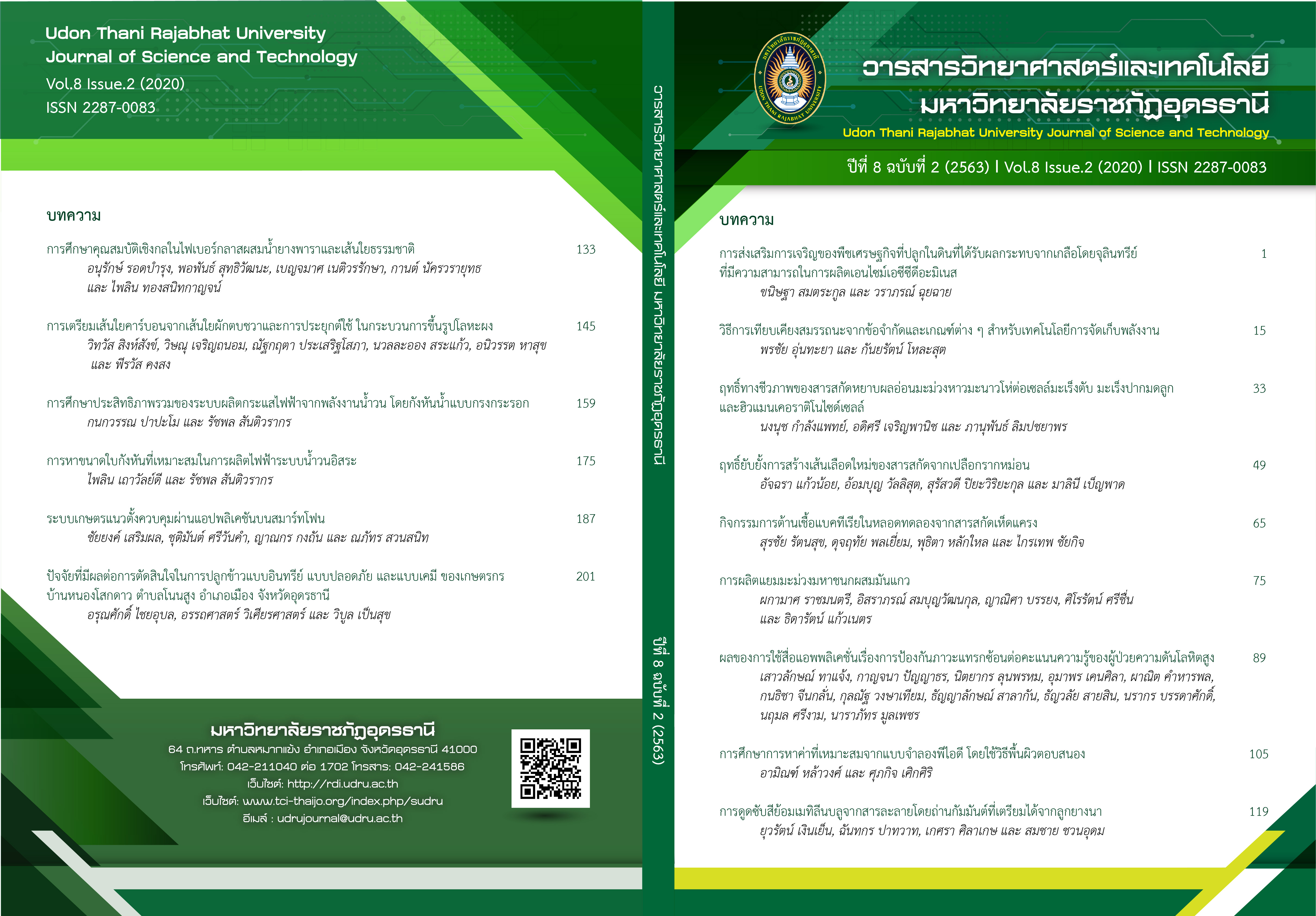EFFECTS OF USING MEDIA APPLICATION ON PREVENTION OF COMPLICATIONS FOR KNOWLEDGE ON PATIENTS WITH HYPERTENSION.
Main Article Content
Abstract
This study was a quasi-experimental research with the following purposes: 1) to study the differences in knowledge of using the application before and after in the experimental group; 2) to compare the differences in knowledge of using the application of the experimental group and control group. The population of the study is 54 patients with hypertension at Ban Kam Kling, Village No. 3, who received services at Ban Chan Health Promoting Hospital, Muang District, Udon Thani Province. From the interview results on general information, there were 20 hypertensive patients that unable to control blood pressures. These were divided into 2 groups: 10 people in the experimental group (patients who could use the application); and 10 people in the control group (patients who do not use the application). The research was conducted from 15 December 2019 to 15 March 2020 or three months in total. The instruments used for data collection were interview form on general information of hypertensive patients, and a test of hypertension and complications knowledge. The general information was analyzed by using descriptive statistics, namely, frequency distribution, and percentage. The differences in knowledge of using the application before and after in the experimental group was analyzed using paired t-test. The comparison of knowledge of using the application between the experimental group and the control group was analyzed by using independent t-test by the statistical significant value of 0.05.
The findings indicate that from the population of 54 people studied, there were female (64.8%) more than males (35.1%). The ages were between 40-60 years and older. Most were elderly people (63%), followed by working aged people (37%). On education, most patients finished elementary education: Pratomsuksa four (55.6%), followed by Pratomsuksa six (22.2%), and secondary education (18.5%). There were 20 patients who were unable to control blood pressures (37%). The factors affected the risk of complications were: 1) failure to control diet: 15 patients (75%) consumed salty foods; 2) overweight of body mass index: the body mass indexes of 11 people were more than 23 kg/m2, (55%); 3) alcohol consumption: seven patients (35%) consumed alcoholic drinks; 4) smoking: four patients (20%) smoked; and 6) medication-taking behaviors did not follow the treatment plan: six patients (30%) failed to take medication as planned. For the results of using the application media, it was found that the posttest mean knowledge scores of the experimental group and the control group was not a statistically significant difference (P<.05). However, the mean score of knowledge on the application use of the experimental group was greater than that of the control group with a statistically significant difference (P <.05). In the era of Thailand 4.0, the use of the knowledge application is suitable to help review or increase knowledge of how to practice for the patients.
Article Details
References
กองยุทธศาสตร์และแผนงาน สำนักงานปลัดกระทรวงสาธารณสุข. (2562). จำนวนและอัตราตายโรคไม่ติดต่อ ปี 2559 - 2561 (รวม 4 โรค/ความดันโลหิตสูง/เบาหวาน/หัวใจขาดเลือด/หลอดเลือดสมอง/หลอดลมอักเสบ/ถุงลมโป่งพอง). สืสืบค้นเมื่อวันที่ 12 กุมภาพันธ์ 2563 จาก http://www.thaincd.com/2016mission/documents-detail.php?id=13653&tid=32&gid=1-020.
ณัฐธิวรรณ พันธุ์มุง, อริสรา อยู่เลิศลบ และ สราญรัตน์ ลัทธิ. (2562). สำนักงานโรคไม่ติดต่อกรมควบคุมโรค. สืบค้นเมื่อวันที่ 4 กุมภาพันธ์ 2563 จาก https:pr.moph.go.th.
กรองทอง คมรัตนปัญญา,ชัยยง ขามรัตน์ และ ทองหล่อ เดชไทย. (2553). ประสิทธิผลการป้องกันภาวะแทรกซ้อนผู้ป่วยความดันโลหิตสูงชนิดไม่ทราบสาเหตุ อำเภอบางไทร จังหวัดพระนครศรีอยุธยา. วารสารวิจัย มข., 15(10), 897-909.
นฤมล โซว์สูงเนิน. (2560). การสร้างเสริมพฤติกรรมสุขภาพของประชาชนวัยทำงานเพื่อป้องโรคความดันโลหิตสูง. วารสารสุขภาพภาคประชาชน, 12(1), 9-16.
ประเสริฐ อัสสันตชัย. (2551). การเปลี่ยนแปลงของระบบประสาท. สืบค้นเมื่อวันที่ 12 กุมภาพันธ์ 2563,จาก,https://www.si.mahidol.ac.th/project/geriatrics/ knowledge article/knowledge healthy_2_008.html.
ผ่องพรรณ อรุณแสง. (2556). การพยาบาลโรคหัวใจและหลอดเลือด. (พิมพ์ครั้งที่ 10). ขอนแก่น: คลังนานาวิทยา.
สมาคมความดันโลหิตสูงแห่งประเทศไทย. (2562). แนวทางการรักษาโรคความดันโลหิตสูง ในเวชปฏิบัติทั่วไป พ.ศ. 2562. เชียงใหม่: ทริค ธิงค์.
อารีย์ แร่ทอง. (2562). ความรอบรู้ด้านสุขภาพและพฤติกรรมสุขภาพ 3อ 2ส ของอาสาสมัครสาธารณสุขประจำหมู่บ้าน กรณีศึกษาตำบลหินตก อำเภอร่อนพิบูลย์ จังหวัดนครศรีธรรมราช. วารสารวิชาการ กรมสนับสนุนบริการสุขภาพ, 15(3),63-70.
American Heart Association. (2016). What are the Symptoms of High Blood Pressure?. Retrieved February 15, 2020, from http://www.heart.org/HEARTORG/Conditions/HighBloodPressure/SymptomsDiagnosisMonitoringofHighBloodPressure/What-are-the-Symptoms-of-High-Blood-Pressure_ UCM_301871_Article.
Batalden, P. B. (1991). Building Knowledge for Quality Improvement in Healthcare: An Introductory Glossary. Journal of Quality Assurance, 13(5), 8–12.
Gerber, B. S., Brodsky, I. G., Lawless, K. A., Smolin, L. I., Arozullah, A. M., Smith, E. V., Berbaum, M. L., Heckerling, P. S., & Eiser, A. R. (2005). Implementation and Evaluation of a Low-Literacy Diabetes Education Computer Multimedia Application. Diabetes Care, 28(7), 1574–1580.
World Health Organization, (WHO). (2019). Hypertension. Retrieved February 15, 2020 from https://www.who.int/news-room/fact-sheets/detail/ hypertension


